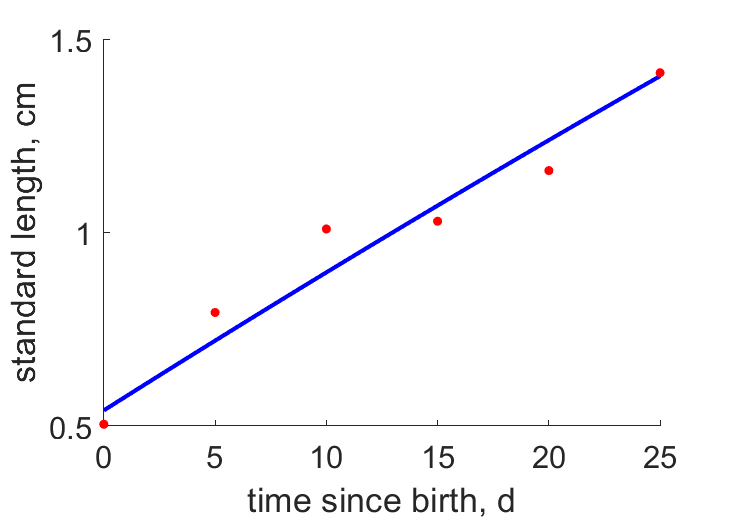Predictions & Data for this entry
| Model: abj | climate: MA | migrate: | phylum: |
| COMPLETE = 2.5 | ecozone: MPW | food: biCi | class: |
| MRE = 0.032 | habitat: 0iMc, 0iMr | gender: D | order: |
| SMSE = 0.002 | embryo: Mnm | reprod: O | family: |
Zero-variate data
| Data | Observed | Predicted | (RE) | Unit | Description | Reference |
|---|---|---|---|---|---|---|
| ab | 7.5 | 7.446 | (0.007177) | d | age at birth | KhooDasa2018 |
| am | 4015 | 4032 | (0.004188) | d | life span | fishbase |
| Lp | 5 | 5.045 | (0.008997) | cm | standard length at puberty | fishbase |
| Li | 12 | 12.35 | (0.02894) | cm | ultimate standard length | fishbase |
| Wwb | 0.0037 | 0.003528 | (0.04659) | g | wet weight at birth | KhooDasa2018 |
| Wwp | 2.9 | 2.869 | (0.01076) | g | wet weight at puberty | fishbase |
| Wwi | 41.5 | 42.06 | (0.01341) | g | ultimate wet weight | fishbase |
| Ri | 19.73 | 18.77 | (0.04852) | #/d | maximum reprod rate | fishbase |
Uni- and bivariate data
| Data | Figure | Independent variable | Dependent variable | (RE) | Reference |
|---|---|---|---|---|---|
| tL |  | time since birth | standard length | (0.05906) | ArveMcCo2000 |
Pseudo-data at Tref = 20°C
| Data | Generalised animal | Amphiprion melanopus | Unit | Description |
|---|---|---|---|---|
| v | 0.02 | 0.02411 | cm/d | energy conductance |
| p_M | 18 | 55.27 | J/d.cm^3 | vol-spec som maint |
| k_J | 0.002 | 0.002 | 1/d | maturity maint rate coefficient |
| k | 0.3 | 0.1888 | - | maintenance ratio |
| kap | 0.8 | 0.841 | - | allocation fraction to soma |
| kap_G | 0.8 | 0.802 | - | growth efficiency |
| kap_R | 0.95 | 0.95 | - | reproduction efficiency |
Discussion
- males are supposed not to differ from females
Facts
- length-weight: Ww in g = 0.0223*(TL in cm)^3.03 (Ref: fishbase)
- Indo-West Pacific: Persian Gulf to Western Australia, throughout the Indo-Australian Archipelago and in the western Pacific at the islands of Melanesia and Micronesia, north to Taiwan, southern Japan and the Ryukyu Islands (Ref: fishbase)
Bibliography